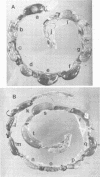Abstract
Food and water samples from an Ethiopian community were screened for the presence of enterotoxin-producing bacteria. Using the Chinese hamster ovary cell assay, 40 of 213 isolates (18.8%) produced heat-labile (LT) enterotoxin. These LT-producing isolates comprised 33 of 177 (18.6%) strains from 24 of 68 food samples (35.3%) and 7 of 36 (19.4%) isolates of 4 of 17 water samples (23.5%). One LT-producing strain each of Salmonella emek and of Shigella dysenteriae was found. Three pseudomonads, all LT producers, produced heat-stable enterotoxin as gauged by the suckling mouse test. Two strains of LT-enterotoxigenic Escherichia coli O68 were found in water samples. No enterotoxigenic E. coli were isolated from food samples, but 13 of the LT-producing strains were Enterobacter, Klebsiella, Serratia, and Proteus species, and 7 food samples yielded more than one species of enterotoxigenic bacterium. Of the enterotoxigenic isolates from food, 15 were oxidase-positive strains of the genera Aeromonas, Pseudomonas, Achromobacter, Flavobacterium, and Vibrio. LT-enterotoxigenic Enterobacter, Acinetobacter, Klebsiella, Proteus, Providencia, and Serratia species represented 20 of the food and water isolates. Culture supernatant fluids of representative strains of oxidase-positive and oxidase-negative species giving positive reactions in Chinese hamster ovary cell tests induced fluid accumulation in rabbit ileal loops. Eight of the food samples and two of the water samples contained more than one isolate or species of enterotoxigenic bacterium. The stability of the LT production by oxidase-positive bacteria and non-E. coli strains was assessed by the rabbit skin and adrenal cell tests after 9 months and 1 year of storage, respectively, in Trypticase soy broth with glycerol at −70°C. Only 33% of the oxidase-positive strains were still LT enterotoxigenic. Of the oxidase-negative strains, 50 and 33% were LT producing at 9 months and 1 year, respectively. None of the E. coli isolates, both enterotoxigenic and nonenterotoxigenic, possessed K88, K99, or colonization factor antigen. The survey demonstrates the presence in food and water of enterotoxigenic bacteria of the same species as those isolated from cases of infantile diarrhea in the same community, although a correlation between these sources and infantile diarrhea remains to be established.
Full text
PDF
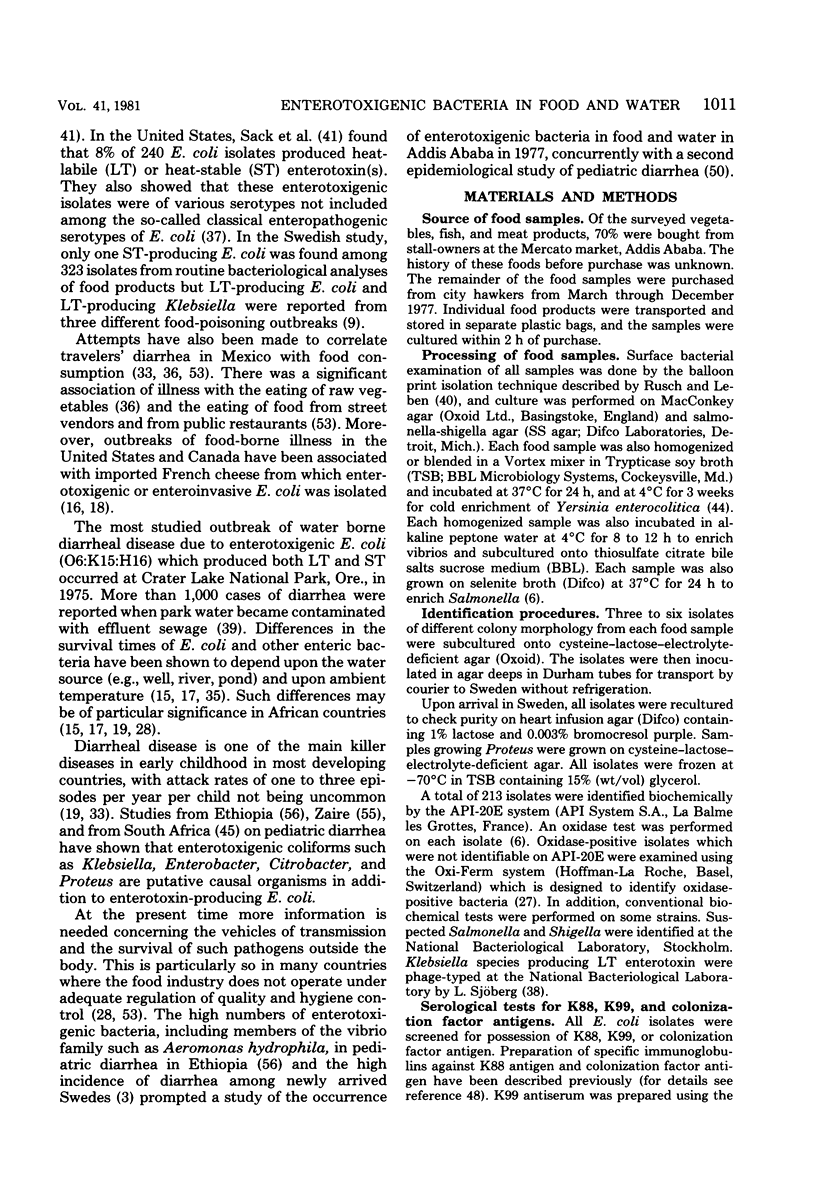
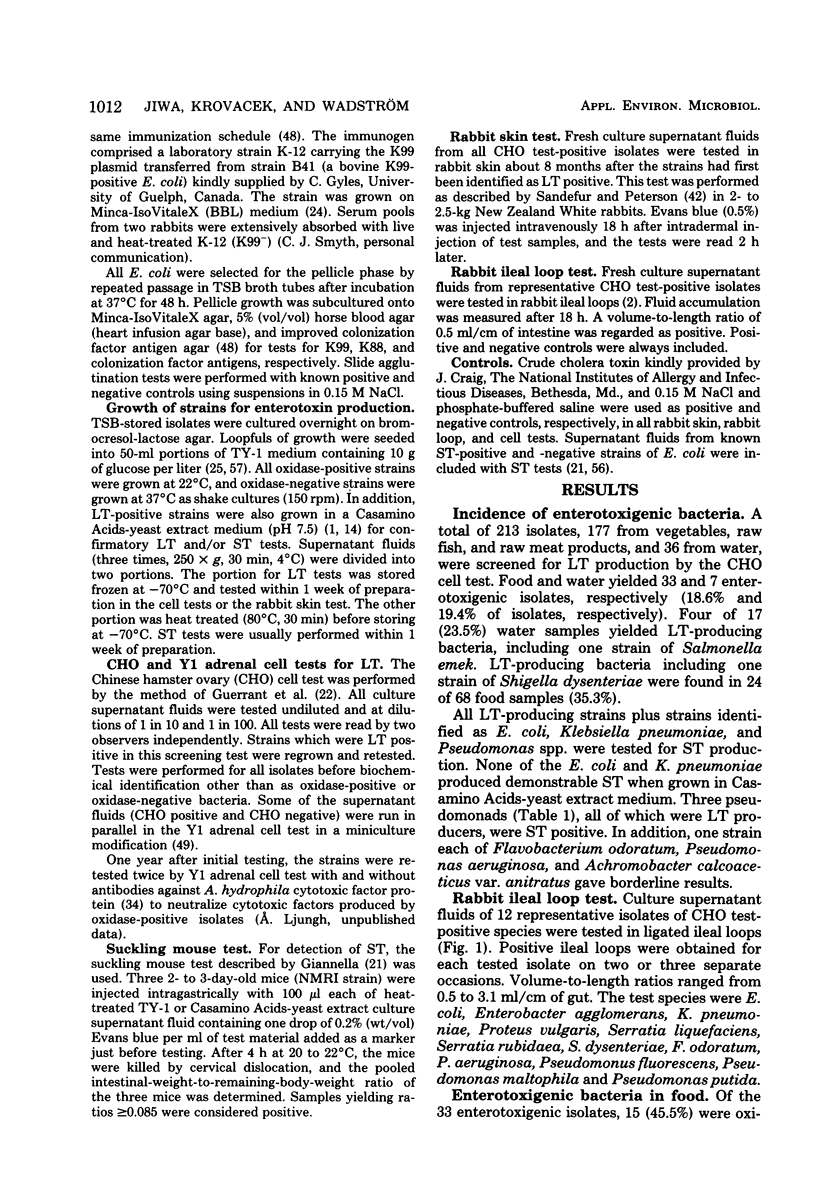
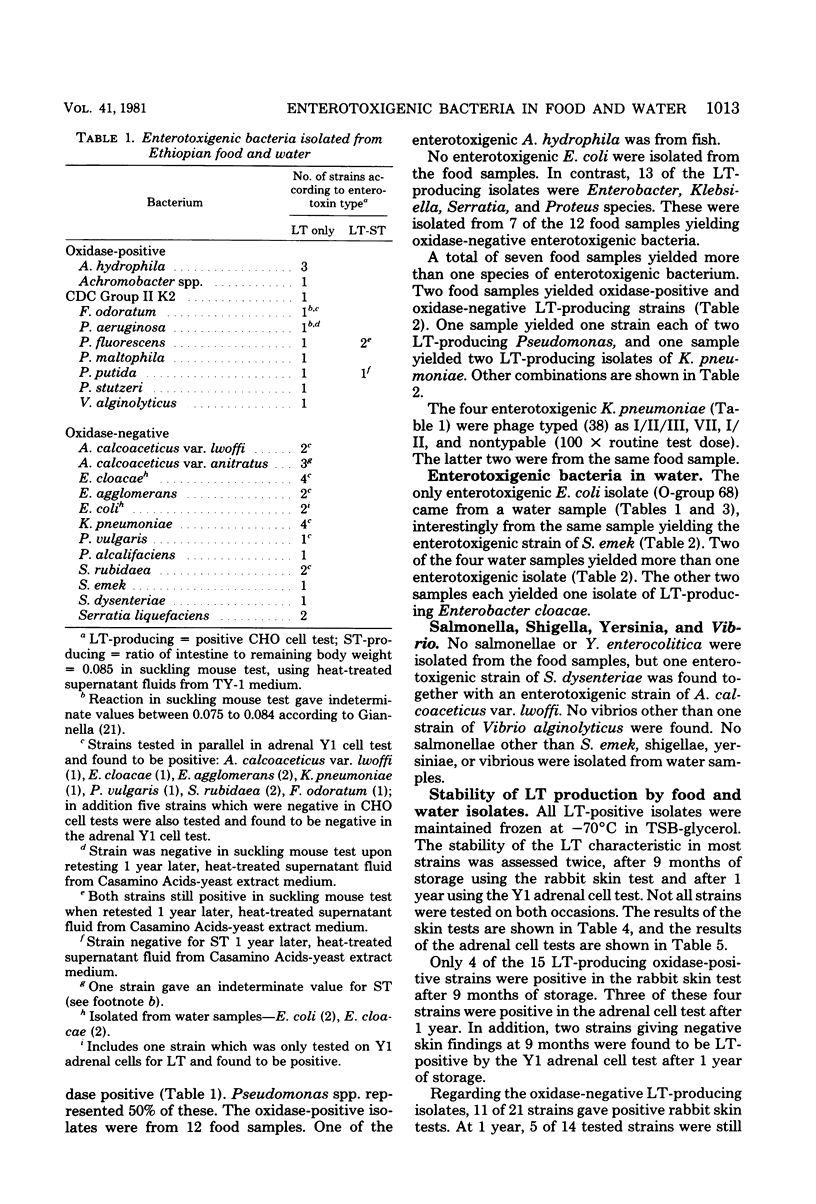
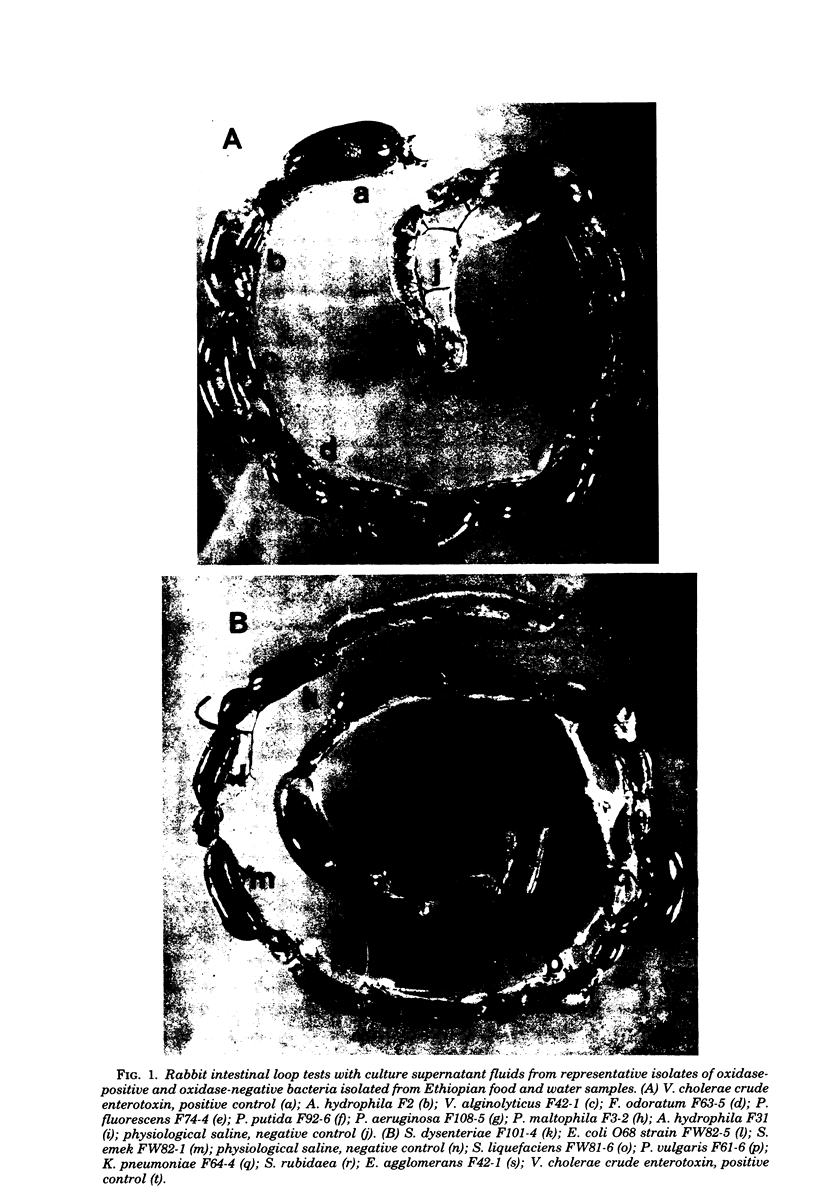
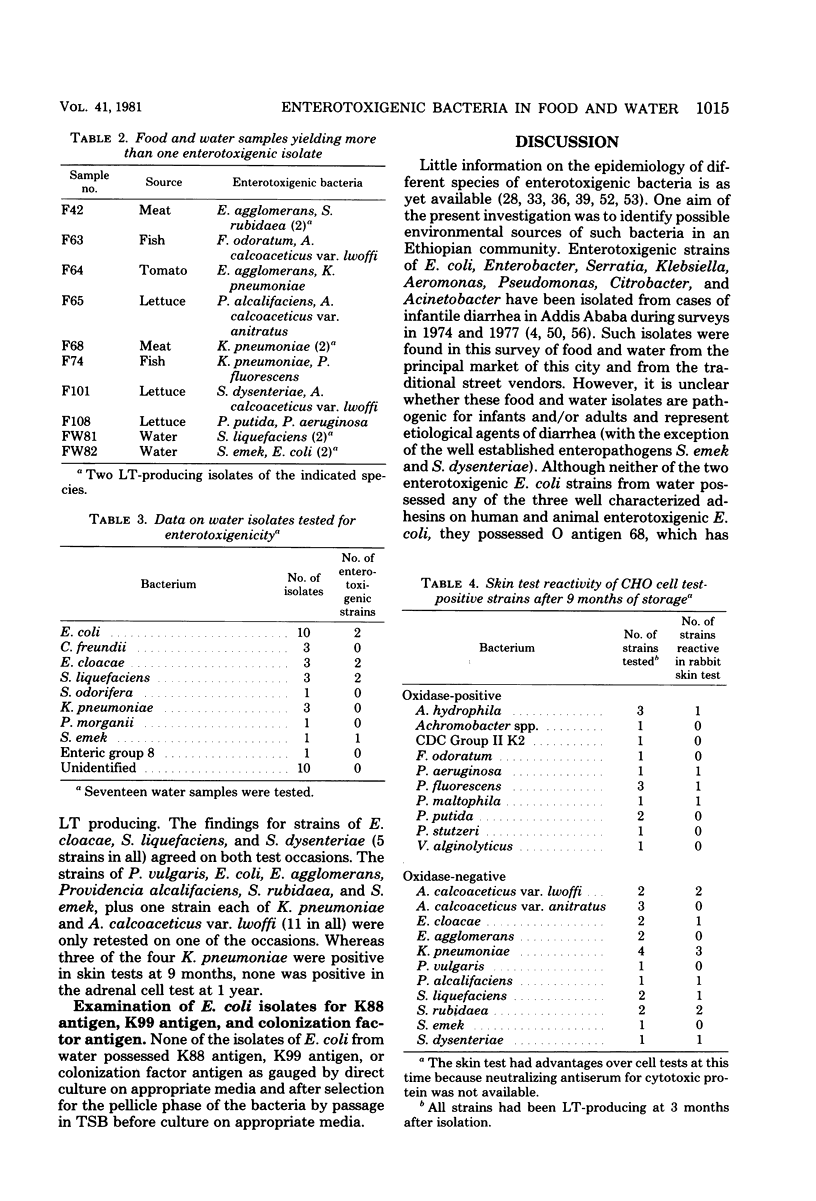
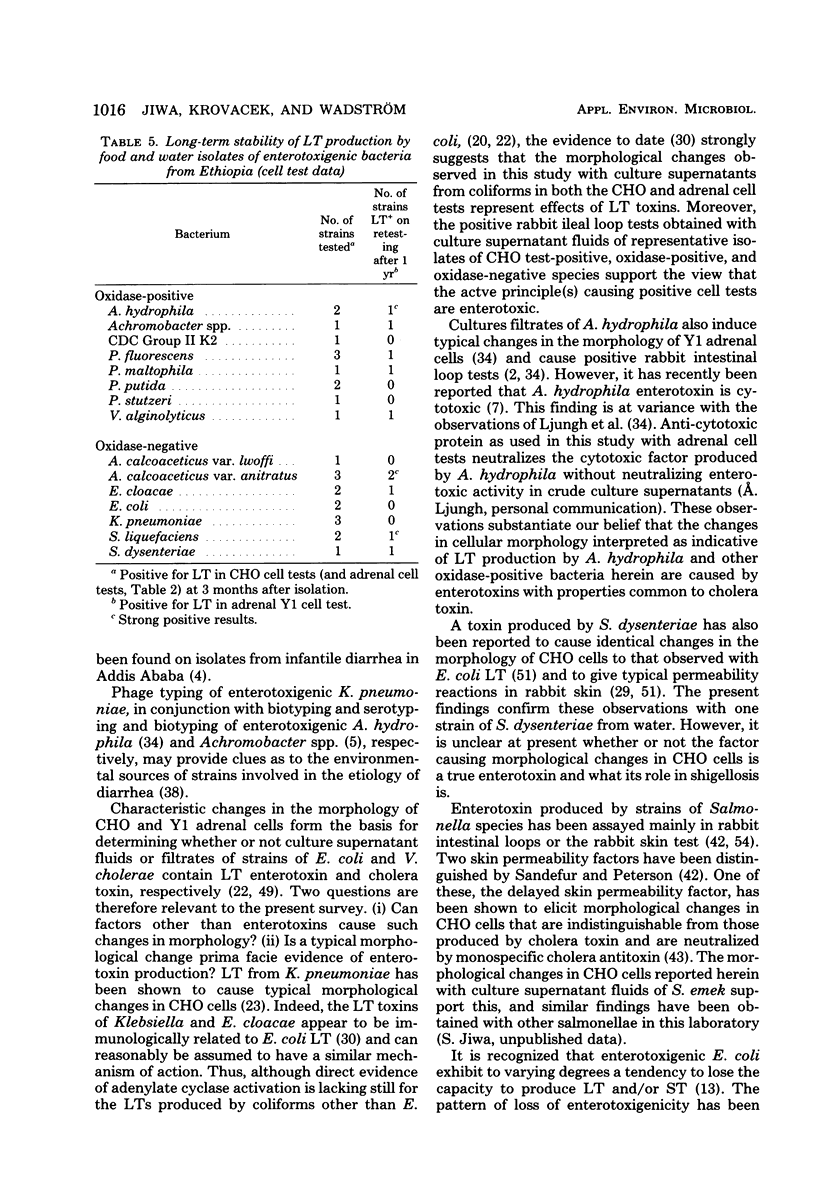
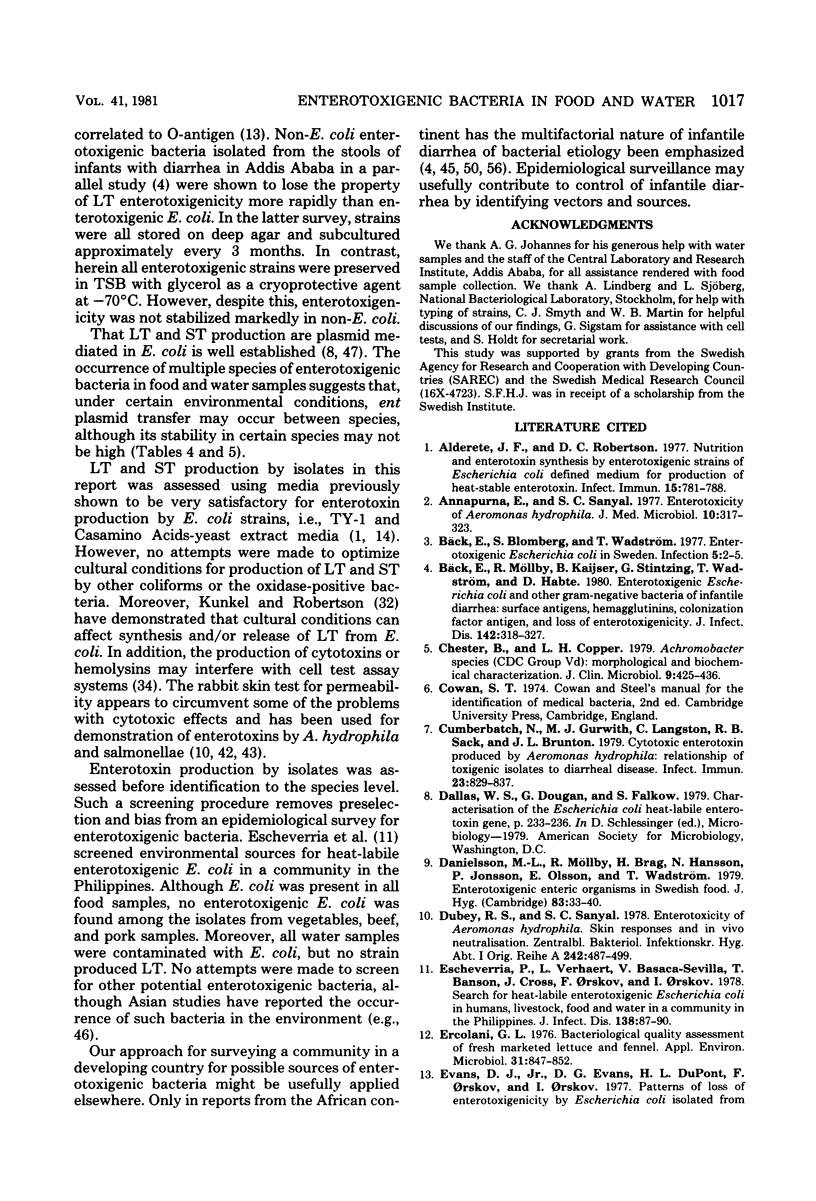
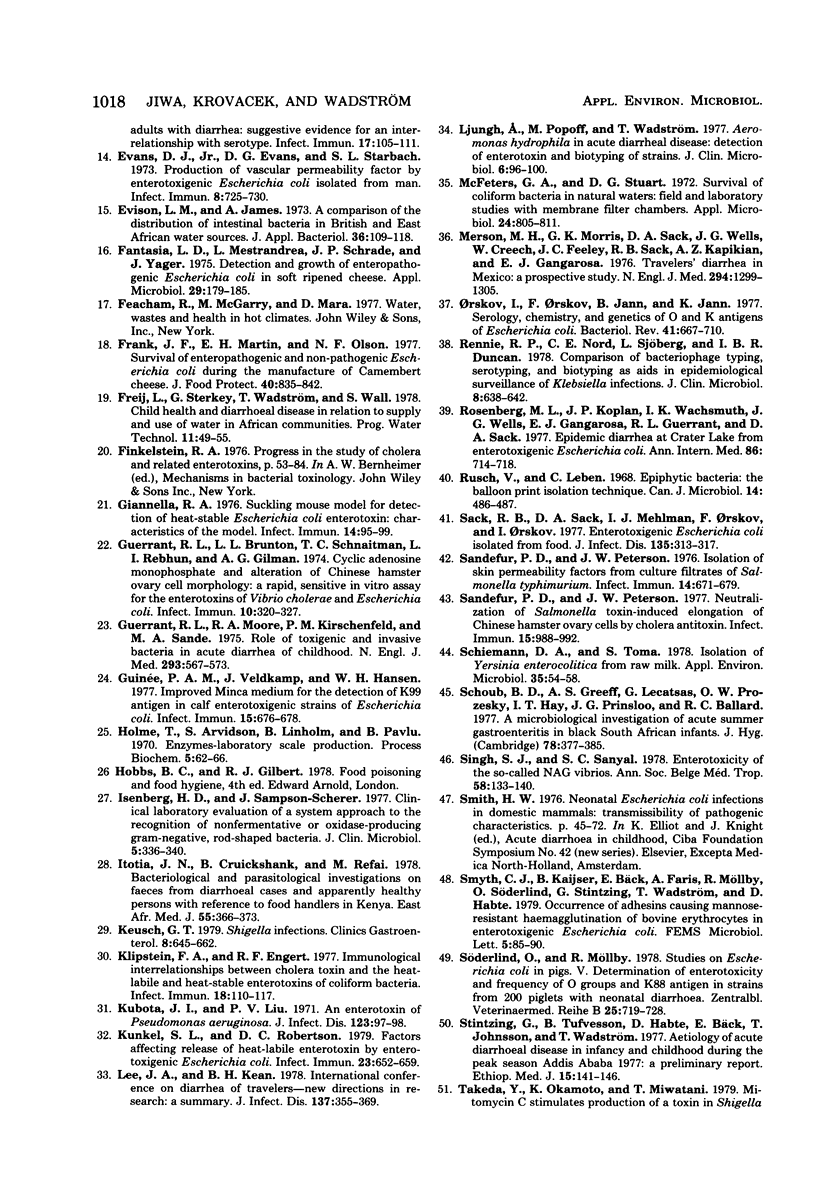
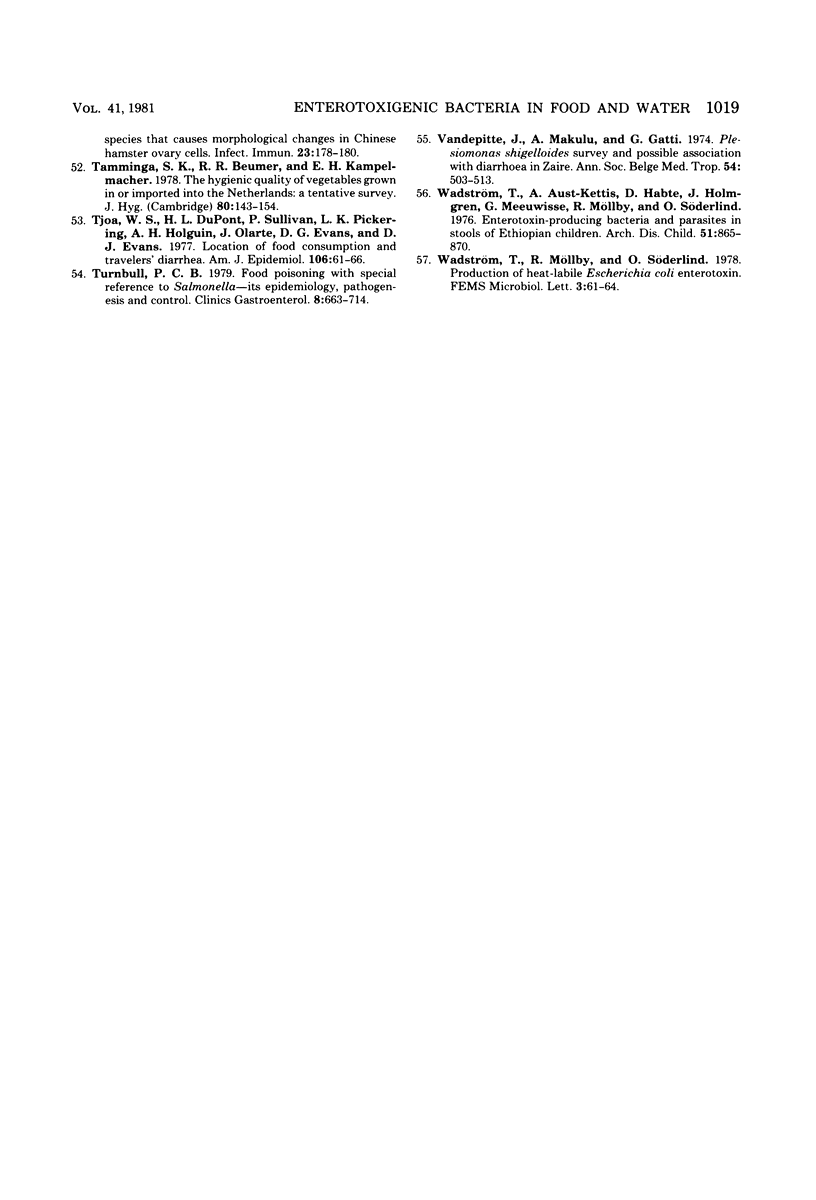
Images in this article
Selected References
These references are in PubMed. This may not be the complete list of references from this article.
- Alderete J. F., Robertson D. C. Nutrition and enterotoxin synthesis by enterotoxigenic strains of Escherichia coli: defined medium for production of heat-stable enterotoxin. Infect Immun. 1977 Mar;15(3):781–788. doi: 10.1128/iai.15.3.781-788.1977. [DOI] [PMC free article] [PubMed] [Google Scholar]
- Annapurna E., Sanyal S. C. Enterotoxicity of Aeromonas hydrophila. J Med Microbiol. 1977 Aug;10(3):317–323. doi: 10.1099/00222615-10-3-317. [DOI] [PubMed] [Google Scholar]
- Bäck E., Möllby R., Kaijser B., Stintzing G., Wadström T., Habte D. Enterotoxigenic Escherichia coli and other gram-negative bacteria of infantile diarrhea: surface antigens, hemagglutinins, colonization factor antigen, and loss of enterotoxigenicity. J Infect Dis. 1980 Sep;142(3):318–327. doi: 10.1093/infdis/142.3.318. [DOI] [PubMed] [Google Scholar]
- Bück E., Blomberg S., Wadström T. Enterotoxigenic Escherichia coli in Sweden. Infection. 1977;5(1):2–5. doi: 10.1007/BF01639100. [DOI] [PubMed] [Google Scholar]
- Chester B., Cooper L. H. Achromobacter species (CDC group Vd): morphological and biochemical characterization. J Clin Microbiol. 1979 Mar;9(3):425–436. doi: 10.1128/jcm.9.3.425-436.1979. [DOI] [PMC free article] [PubMed] [Google Scholar]
- Cumberbatch N., Gurwith M. J., Langston C., Sack R. B., Brunton J. L. Cytotoxic enterotoxin produced by Aeromonas hydrophila: relationship of toxigenic isolates to diarrheal disease. Infect Immun. 1979 Mar;23(3):829–837. doi: 10.1128/iai.23.3.829-837.1979. [DOI] [PMC free article] [PubMed] [Google Scholar]
- Danielsson M. L., Möllby R., Brag H., Hansson N., Jonsson P., Olsson E., Wadström T. Enterotoxigenic enteric bacteria in foods and outbreaks of food-borne diseases in Sweden. J Hyg (Lond) 1979 Aug;83(1):33–40. doi: 10.1017/s0022172400025808. [DOI] [PMC free article] [PubMed] [Google Scholar]
- Dubey R. S., Sanyal S. C. Enterotoxicity of Aeromonas hydrophila: skin responses and in vivo neutralisation. Zentralbl Bakteriol Orig A. 1978 Dec;242(4):487–499. [PubMed] [Google Scholar]
- Echeverria P., Verhaert L., Basaca-Sevilla V., Banson T., Cross J., Orskov F., Orskov I. Search for heat-labile enterotoxigenic Escherichia coli in humans, livestock, food, and water in a community in the Philippines. J Infect Dis. 1978 Jul;138(1):87–90. doi: 10.1093/infdis/138.1.87. [DOI] [PubMed] [Google Scholar]
- Ercolani G. L. Bacteriological quality assessment of fresh marketed lettuce and fennel. Appl Environ Microbiol. 1976 Jun;31(6):847–852. doi: 10.1128/aem.31.6.847-852.1976. [DOI] [PMC free article] [PubMed] [Google Scholar]
- Evans D. J., Jr, Evans D. G., Gorbach S. L. Production of vascular permeability factor by enterotoxigenic Escherichia coli isolated from man. Infect Immun. 1973 Nov;8(5):725–730. doi: 10.1128/iai.8.5.725-730.1973. [DOI] [PMC free article] [PubMed] [Google Scholar]
- Evison L. M., James A. A comparison of the distribution of intestinal bacteria in British and East African water sources. J Appl Bacteriol. 1973 Mar;36(1):109–118. doi: 10.1111/j.1365-2672.1973.tb04078.x. [DOI] [PubMed] [Google Scholar]
- Fantasia L. D., Mestrandrea L., Schrade J. P., Yager J. Detection and growth of enteropathogenic Escherichia coli in soft ripened cheese. Appl Microbiol. 1975 Feb;29(2):179–185. doi: 10.1128/am.29.2.179-185.1975. [DOI] [PMC free article] [PubMed] [Google Scholar]
- Giannella R. A. Suckling mouse model for detection of heat-stable Escherichia coli enterotoxin: characteristics of the model. Infect Immun. 1976 Jul;14(1):95–99. doi: 10.1128/iai.14.1.95-99.1976. [DOI] [PMC free article] [PubMed] [Google Scholar]
- Guerrant R. L., Brunton L. L., Schnaitman T. C., Rebhun L. I., Gilman A. G. Cyclic adenosine monophosphate and alteration of Chinese hamster ovary cell morphology: a rapid, sensitive in vitro assay for the enterotoxins of Vibrio cholerae and Escherichia coli. Infect Immun. 1974 Aug;10(2):320–327. doi: 10.1128/iai.10.2.320-327.1974. [DOI] [PMC free article] [PubMed] [Google Scholar]
- Guerrant R. L., Moore R. A., Kirschenfeld P. M., Sande M. A. Role of toxigenic and invasive bacteria in acute diarrhea of childhood. N Engl J Med. 1975 Sep 18;293(12):567–572. doi: 10.1056/NEJM197509182931201. [DOI] [PubMed] [Google Scholar]
- Guinée P. A., Veldkamp J., Jansen W. H. Improved minca medium for the detection of K99 antigen in calf enterotoxigenic strains of Escherichia coli. Infect Immun. 1977 Feb;15(2):676–678. doi: 10.1128/iai.15.2.676-678.1977. [DOI] [PMC free article] [PubMed] [Google Scholar]
- Isenberg H. D., Sampson-Scherer J. Clinical laboratory evaluation of a system approach to the recognition of nonfermentative or oxidase-producing gram-negative, rod-shaped bacteria. J Clin Microbiol. 1977 Mar;5(3):336–340. doi: 10.1128/jcm.5.3.336-340.1977. [DOI] [PMC free article] [PubMed] [Google Scholar]
- Itotia J. N., Cruickshank B., Refai M. Bacteriological and parasitological investigations of faeces from diarrhoeal cases and apparently healthy persons with reference to food handlers in Kenya. East Afr Med J. 1978 Aug;55(8):366–372. [PubMed] [Google Scholar]
- Keusch G. T. Shigella infections. Clin Gastroenterol. 1979 Sep;8(3):645–662. [PubMed] [Google Scholar]
- Klipstein F. A., Engert R. F. Immunological interrelationships between cholera toxin and the heat-labile and heat-stable enterotoxins of coliform bacteria. Infect Immun. 1977 Oct;18(1):110–117. doi: 10.1128/iai.18.1.110-117.1977. [DOI] [PMC free article] [PubMed] [Google Scholar]
- Kubota Y., Liu P. V. An enterotoxin of Pseudomonas aeruginosa. J Infect Dis. 1971 Jan;123(1):97–98. doi: 10.1093/infdis/123.1.97. [DOI] [PubMed] [Google Scholar]
- Kunkel S. L., Robertson D. C. Factors affecting release of heat-labile enterotoxin by enterotoxigenic Escherichia coli. Infect Immun. 1979 Mar;23(3):652–659. doi: 10.1128/iai.23.3.652-659.1979. [DOI] [PMC free article] [PubMed] [Google Scholar]
- Ljungh A., Popoff M., Wadstrom T. Aeromonas hydrophila in acute diarrheal disease: detection of enterotoxin and biotyping of strains. J Clin Microbiol. 1977 Aug;6(2):96–100. doi: 10.1128/jcm.6.2.96-100.1977. [DOI] [PMC free article] [PubMed] [Google Scholar]
- McFeters G. A., Stuart D. G. Survival of coliform bacteria in natural waters: field and laboratory studies with membrane-filter chambers. Appl Microbiol. 1972 Nov;24(5):805–811. doi: 10.1128/am.24.5.805-811.1972. [DOI] [PMC free article] [PubMed] [Google Scholar]
- Merson M. H., Morris G. K., Sack D. A., Wells J. G., Feeley J. C., Sack R. B., Creech W. B., Kapikian A. Z., Gangarosa E. J. Travelers' diarrhea in Mexico. A prospective study of physicians and family members attending a congress. N Engl J Med. 1976 Jun 10;294(24):1299–1305. doi: 10.1056/NEJM197606102942401. [DOI] [PubMed] [Google Scholar]
- Orskov I., Orskov F., Jann B., Jann K. Serology, chemistry, and genetics of O and K antigens of Escherichia coli. Bacteriol Rev. 1977 Sep;41(3):667–710. doi: 10.1128/br.41.3.667-710.1977. [DOI] [PMC free article] [PubMed] [Google Scholar]
- Rennie R. P., Nord C. E., Sjoberg L., Duncan I. B. Comparison of bacteriophage typing, serotyping, and biotyping as aids in epidemiological surveillance of Klebsiella infections. J Clin Microbiol. 1978 Dec;8(6):638–642. doi: 10.1128/jcm.8.6.638-642.1978. [DOI] [PMC free article] [PubMed] [Google Scholar]
- Rosenberg M. L., Koplan J. P., Wachsmuth I. K., Wells J. G., Gangarosa E. J., Guerrant R. L., Sack D. A. Epidemic diarrhea at Crater Lake from enterotoxigenic Escherichia coli. A large waterborne outbreak. Ann Intern Med. 1977 Jun;86(6):714–718. doi: 10.7326/0003-4819-86-6-714. [DOI] [PubMed] [Google Scholar]
- Rusch V., Leben C. Epiphytic microflora: the balloon print isolation technique. Can J Microbiol. 1968 Apr;14(4):486–487. doi: 10.1139/m68-080. [DOI] [PubMed] [Google Scholar]
- Sack R. B., Sack D. A., Mehlman I. J., Orskov F., Orskov I. Enterotoxigenic Escherichia coli isolated from food. J Infect Dis. 1977 Feb;135(2):313–317. doi: 10.1093/infdis/135.2.313. [DOI] [PubMed] [Google Scholar]
- Sandefur P. D., Peterson J. W. Isolation of skin permeability factors from culture filtrates of Salmonella typhimurium. Infect Immun. 1976 Sep;14(3):671–679. doi: 10.1128/iai.14.3.671-679.1976. [DOI] [PMC free article] [PubMed] [Google Scholar]
- Sandefur P. D., Peterson J. W. Neutralization of Salmonella toxin-induced elongation of Chinese hamster ovary cells by cholera antitoxin. Infect Immun. 1977 Mar;15(3):988–992. doi: 10.1128/iai.15.3.988-992.1977. [DOI] [PMC free article] [PubMed] [Google Scholar]
- Schiemann D. A., Toma S. Isolation of Yersinia enterocolitica from raw milk. Appl Environ Microbiol. 1978 Jan;35(1):54–58. doi: 10.1128/aem.35.1.54-58.1978. [DOI] [PMC free article] [PubMed] [Google Scholar]
- Schoub B. D., Greeff A. S., Lecatsas G., Prozesky O. W., Hay I. T., Prinsloo J. G., Ballard R. C. A microbiological investigation of acute summer gastroenteritis in black South African infants. J Hyg (Lond) 1977 Jun;78(3):377–385. doi: 10.1017/s0022172400056278. [DOI] [PMC free article] [PubMed] [Google Scholar]
- Singh S. J., Sanyal S. C. Enterotoxicity of the so-called NAG vibrios. Ann Soc Belg Med Trop. 1978;58(2):133–140. [PubMed] [Google Scholar]
- Stintzing G., Tufvesson B., Habte D., Back E., Johnsson T., Wadstrom T. Aetiology of acute diarrhoeal disease in infancy and childhood, during the peak season Addis Ababa 1977: a preliminary report. Ethiop Med J. 1977 Oct;15(4):141–146. [PubMed] [Google Scholar]
- Söderlind O., Möllby R. Studies on Escherichia coli in pigs V. Determination of enterotoxicity and frequency of O groups and K 88 antigen in strains from 200 piglets with neonatal diarrhoea. Zentralbl Veterinarmed B. 1978 Nov;25(9):719–728. [PubMed] [Google Scholar]
- Takeda Y., Okamoto K., Miwatani T. Mitomycin C stimulates production of a toxin in Shigella species that causes morphological changes in Chinese hamster ovary cells. Infect Immun. 1979 Jan;23(1):178–180. doi: 10.1128/iai.23.1.178-180.1979. [DOI] [PMC free article] [PubMed] [Google Scholar]
- Tamminga S. K., Beumer R. R., Kampelmacher E. H. The hygienic quality of vegetables grown in or imported into the Netherlands: a tentative survey. J Hyg (Lond) 1978 Feb;80(1):143–154. doi: 10.1017/s002217240005347x. [DOI] [PMC free article] [PubMed] [Google Scholar]
- Tjoa W. S., DuPont H. L., Sullivan P., Pickering L. K., Holguin A. H., Olarte J., Evans D. G., Evans D. J., Jr Location of food consumption and travelers' diarrhea. Am J Epidemiol. 1977 Jul;106(1):61–66. doi: 10.1093/oxfordjournals.aje.a112433. [DOI] [PubMed] [Google Scholar]
- Turnbull P. C. Food poisoning with special reference to Salmonella -- its epidemiology, pathogenesis and control. Clin Gastroenterol. 1979 Sep;8(3):663–714. [PubMed] [Google Scholar]
- Vandepitte J., Makulu A., Gatti F. Plesiomonas shigelloides. Survey and possible association with diarrhoea in Zaïre. Ann Soc Belg Med Trop. 1974;54(6):503–513. [PubMed] [Google Scholar]
- Wadström T., Aust-Kettis A., Habte D., Holmgren J., Meeuwisse G., Möllby R., Söderlind O. Enterotoxin-producing bacteria and parasites in stools of Ethiopian children with diarrhoeal disease. Arch Dis Child. 1976 Nov;51(11):865–870. doi: 10.1136/adc.51.11.865. [DOI] [PMC free article] [PubMed] [Google Scholar]



